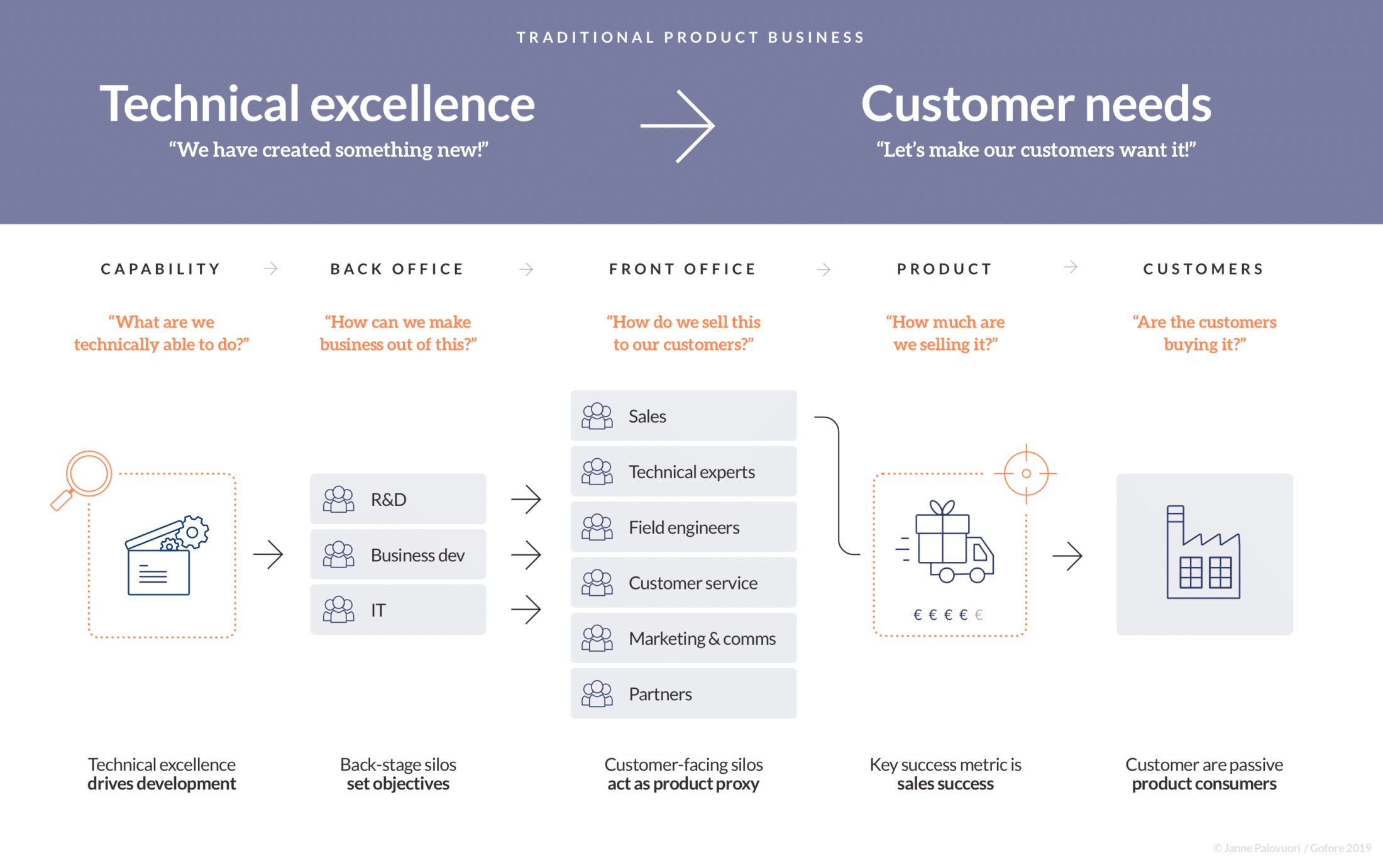In the business of digital services, the customer is the boss, and the value the customer sees, feels, and perceives is the only metric that matters. But what does it take for a traditional product business to turn into a customer value-driven service provider?

Bad services come into the bargain with products. Great services replace the need to buy them – or make them obsolete altogether.
When products no longer satisfy
Traditional B2B product companies are struggling to stay relevant. Research & Development pushes out new technology faster than ever, and every step of the manufacturing process to logistics has been fine-tuned to perfection to offer the best quality-price ratio to customers.
The products have never been better, yet the sales forecasts are looking grim: traditional businesses are losing more deals every year while those businesses that manage to listen and react on their customers’ needs the quickest, flourish. What’s going on?

Traditional product business relies on technical excellence. The customers are passive consumers of the product.
The day the customers changed their minds
Meet Maria, the plant manager at Industry Inc., a mid-sized manufacturing company.
On an average Monday, Maria continues working on the newest tender for the plant. With the help of her team, she’s already narrowed the options down to two. It’s time to make the final call.
Option 1 is a trusted, familiar dealer, offering an excellent product. History has shown that it’s a good choice, and the price is the same as always.
In Option 2, the provider is offering a partnership focusing on improving the plant’s process performance. The product itself is one component of the service and is included in the monthly invoice. With the service, the provider promises to remove a few of the manager’s, engineers’ and the operators’ manual tasks. “These sure are tedious and time-consuming tasks,” she notes. “I wouldn’t lose anything important and could focus my efforts into more strategic questions.” “Actually, with these key figures, we’d be able to plan our budgets six months in advance. That’d make our jobs a lot easier.”
Option 2 sounds like a better choice, but also more expensive. But after adding up the benefits, Maria comes to the conclusion that the true potential is in the long game.
“Maybe we should give it a try. If everything fails, we can always go back to the good old Option 1,” she decides.
And they never go back to Option 1.
Hard numbers drive the discussion, but perceived value tips the scales
In B2B, direct cost is always a major criterion in decision-making, but certainly not the only one. The technical excellence of the products is already taken for granted by the customers – in the end, what really makes the difference is the total value the customer feels like they are getting.
How much do you value removing the mundane tasks you dislike? What about being able to consult experts in decision-making when needed? Sharing the risks with someone? Or making you feel like a better professional at your job?
We all choose the best option for ourselves, and for the context in which we live. People value things differently, and these values are rarely visible to the naked eye.
Knowing the people behind the billing address
No business can afford to create something their customers don’t accept. But who exactly do we mean when we say ‘the customers’?
In the digital service business, customers are not passive entities that consume what the business offers – they are people with different roles, needs, and motivations of their own.
Find out who your customers are, and what they need and value. Focus your efforts on doing the most important bits for them. (it’s worth mentioning that customer needs and wants are two different things – customer-centricity doesn’t mean you have to say ’yes’ to every customer wish!)
When true customer insight starts driving decision-making, customers become the new objective setters for your business. Those objectives start driving the technical excellence of your business. The whole current changes direction.

The digital service business relies on customer insight. Answering to the needs of the customers drives the objectives of the whole organization.
Getting out of the black box
Creating something new never comes without risk, but you can avoid flying blind.
You need to learn how to collaborate with your customers’ key people. You need to be able to test your assumptions and ideas with them before they’re built.
It takes courage to challenge your own assumptions and approach customers with hypothetical scenarios and prototypes. Nobody likes having their ideas shot down, but it’s always better to fail with a two-month-old concept than with a launched service that’s been developed over years.
”But can we do that? What will our customers think?”
You’ll be surprised how eagerly people reserve an hour of their time to help create something that will, in the end, make their own lives easier. They’ll appreciate the opportunity to get their voices heard and make a difference. If you’re well prepared and have the right professionals to do it, people will want to pitch in. Or, at the very least they’ll appreciate that they were asked.
With the resulting, rich insight, you’ll notice that it’s much easier to make decisions on where to head next, what to change, and what to keep.
Playing the long game
Services are never ready. The service provider’s responsibility does not end when the first version is out and the first deal is won. That’s where the real acid test begins.
With services, the strength of the customer relationship is put to a test every single day. Even the best customer insight stales with time: customer needs and priorities change, and the service needs to be able to evolve with them.
Meeting and exceeding customer expectations demands resources, commitment, and, most importantly, continuous development. But the work pays off with strong and honest relationships that last. Such relationships create long-term value for both parties.
Fortune favours those who are driven by customer value
In the game of customer experience, fortune favours those who truly know and collaborate with the people behind the customer accounts, anticipate and react quickly to changes in the environment, and keep delivering their promises day after day.
Find out who your customers are and figure out what they find meaningful. Be prepared to challenge your own assumptions. Find the courage to test concepts with your customers’ key roles before they are built.
It takes courage, a change of mindset, and realignment in the way the business operates internally. But at the turn of the tide, that’s the price of staying afloat.



